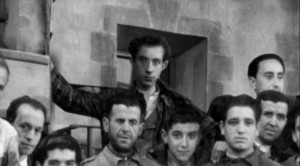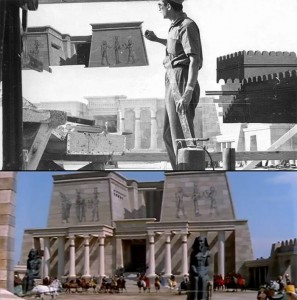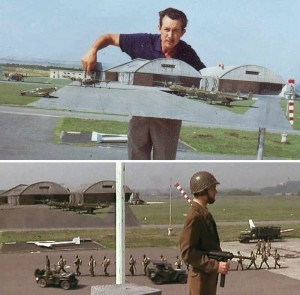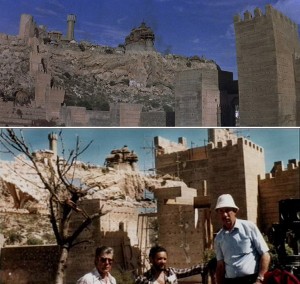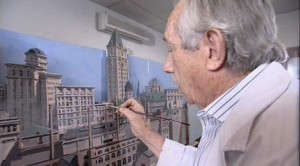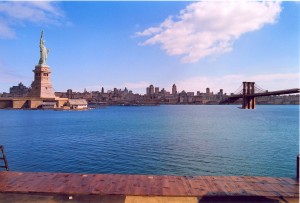Biography:
Emilio Ruiz del Río, was born in Madrid, Spain in 1923.
In 1942 he started to work at Chamartin Studios in Madrid as assistant of scenic painter Enrique Salvá, a well-known landscape painter, who became scenic artist and later on art director.
For the next few years Enrique Salvá and his young assistant shared the work painting scenic backdrops and glass paintings. At the 40´s they worked at more than 10 films by year, it was an exciting, wild and crazy experience painting always under pressure, always running from one to another studio. Salvá was the fastest and most wanted background painter, and Emilio was forced to learn fast, how to paint bakings and glasses.
It was in 1955 during the filming of “La cruz de Mayo” when Emilio discovered a new system. He had just completed a painting of a cityscape on a huge sheet of glass. When Emilio arrived to the studio at the morning, he found the glass cracked. Probably caused by the extreme cold during the night. They did not have time to prepare a new glass, so Emilio asked the construction team to help him cut a wooden silhouette of the city. He then painted the required scenic effect over the masonite surface. The shot was a huge success and Emilio immediately saw the advantages of using the painted cut out rather than the old glass shot. There wasn’t the problem of unwanted reflections showing up on the sheet of glass, and it was more easily set up and lighter to handle. Emilio thought about some other material lighter than the wood and finally came up with the idea of using a thin aluminium cut out piece. From then on, depending on the requirements of the production he used both techniques, glass and aluminium cut out, the last one more often mostly because was a cheaper and easy to handle one.
When the Italian producer Italo Zingarelli came to Spain to supervise the exterior shooting of his films at thge late 50´s , he saw one of Emilio’s on location paintings and became aware of the extremely useful he could be for his next epic projects. During a decade, Emilio Ruiz worked with him travelling for Europe, painting miniatures in Italy, Yugoslavia, Hungry, etc, for sword and sandal and war movies like “The Last Days of Pompeii” (1959), “Legions of the Nile” (1960), “The Colossus of Rhodes” (1961) or “The Invincible Seven” (1963).
These were years of fast painting and learning by doing hundreds of in camera trick shots. He began to explore new ways to give realism and movement to some of his paintings. He started to make armies of small soldiers silhouettes glued over hidden belts, moved by a crank. For a Roman Circus shot, he included hundreds of small rubber figures in a cut out painting, moved along with hidden wires. He also provided armies and vehicles moving through miniatures and squadrons of airplanes painted on a moving sheet of glass, for war movies.
Emilio’s filmography was full of international names like Mann, Lean, Cukor, Annakin, Vidor, Buñuel, Welles, Lester, Siodmak and Kubrick. He also worked on some of the films of Ray Harryhausen, painting backdrops on the early ones and in camera glass shots for the last Sinbad films. He collaborate at the epic films produced by Samuel Bronston in Spain.
It was during these years after the huge experience working on the cheap low budget Italian films when he begun to get involved in some projects on a big or medium budget where they required his skills, and he could use foreground miniatures instead of the painting cut out, which was cheaper.
In Spain, he collaborated with Juan Piquer Simon on a series of fantasy and adventure films – generally made on a low budget. Piquer counted on with some other professionals of equal talent of Emilio, like Francisco Prosper. (Prosper, although was specialised on three-dimensional miniatures, he also made some matte paintings by himself)
In the early 80´s, Emilio had another lucky encounter with an Italian producer; this time was Dino de Laurentiis who came to Spain for the shooting of the first Conan film.
Emilio Ruiz was commissioned to build the miniatures. Due to the ample budget, he used foreground model miniatures for most of the shots and only made used of glass shots for some fast solving solutions.
De Laurentiis was so satisfied with his work; the he embarked him on his next futuristic epic project, Dune. Emilio Ruiz went to Mexico for almost one year to make the most big and spectacular foreground miniatures he had made to date.
During the last two decades, he kept working with his traditional techniques providing glass paintings, cut out miniatures and foreground models for Spanish, French, Italian and American films. With the advent of the digital era, he became probably the last practitioner of the old art of glass painting in the world. When all the matte painters around the world were forced to put aside their brushes for the digital palette, Emilio kept alive the tradition of the old pioneers, like Norman Dawn or Percy Day.
Some of his last contributions were “The Bridge of San Luis Rey” (2004), or “Pan’s Labyrinth” (2006)
In 2007, he was asked to collaborate on a documentary on his life and career. It was during the filming of the documentary “El ultimo truco”(2008) when he became ill and died at the age of 84, some weeks after filming his last foreground miniature and cut out painting trick.
19 years old Emilio Ruiz begun at Chamartin film Studios art department.
A young Emilio Rioz (right) with his mentor Enrique Salvá (left) in front of the sets for Alba de America. The final painting below.
Emilio Ruiz at 1959 painting a glass shoot for Legionsof the Nile.
For the Italian War film Dirty Heroes (1967) Emilio painted several in camera tricks.
One of the many Foreground miniatures that Emilio and his team made for Conan (1982)
One of the last painting of Ruiz del Rio, for the film Luz de Domingo (2007)
Summarised Filmography:
1942 Goyescas
1942 Rojo y negro
1943 El abanderado
1943 Ídolos
1944 Inés de Castro
1944 El clavo
1945 Los últimos de Filipinas
1945 Espronceda
1946 El crimen de la calle Bordadores
1946 Cuando llegue la noche
1946 La pródiga
1947 Fuenteovejuna
1948 Locura de amor
1948 Don Quijote de la Mancha
1949 La Duquesa de Benamejí
1950 Agustina de Aragón
1950 Pequeñeces
1951 Alba de América
1951 La leona de Castilla
1951 Ronda española
1952 El andén
1952 Amaya
1953 El beso de Judas
1954 El indiano
1954 Aventuras del barbero de Sevilla
1955 La cruz de mayo
1955 Mister Arkadin
1955 Alexander the great
1956 Embajadores en el infierno
1957 Robinsón (Un petit coin de paradis)
1957 The pride and the passion
1957 The Sword and the Cross
1958 John Paul Jones
1958 The 7th Voyage of Sinbad
1958 The warrior and the slave girl
1959 The 3 Worlds of Gulliver
1959 Salomon and Sheba
1959 Legions of the Nile
1960 El Cid Anthony Mann
1960 Spartacus
1961 King of Kings
1961 The Colossus of Rhodes
1962 Medusa Against the Son of Hercules
1962 The Invincible Gladiator
1962 Cleopatra
1963 55 days in Pekín
1963 The fall of the Roman Empire
1963 Samson and the Mighty Challenge
1964 El fabuloso mundo del circo Henry Hathaway
1965 Doctor Zhivago
1965 Battle of the Bulge
1965 Chimes at midnight
1966 Return of tyhe seven
1966 Lost command
1967 Dirty heroes
1967 Custer of the West
1968 Villa rides
1969 Krakatoa
1969 Patton
1969 The royal hunt of the sun
1970 The horsemen
1970 The great white hope
1970 cannon for Córdoba
1971Nicolás and Alexandra
1972 Treasure island
1972 Marco Antonio and Cleopatra
1973 The héroes
1973 The golden voyage of simbad
1974 The Living Dead at Manchester Morgue
1975 Zorro
1975 The wind and the lion
1976 The Loves and Times of Scaramouche
1977 Where Time Began
1978 The inglorious bastards
1978 The Humanoid
1979 Operación Ogro
1979 Fortunata y Jacinta (tv Series)
1979 Supersonic man
1981 Conan the barbarian
1981 Mystery on Monster Island
1982 Pieces
1982 Iron master
1983 The Pod People
1984 Dune
1984 Conan the destroyer
1985 Cat’s eye
1985 Red Sonja
1986 Tai-Pan
1986 Maximun overdriv
1987 Space island
1987 Slugs: the movie
1987 Million dollar mystery
1989 The rift
1990 Navy Seals
1990-91 La Révolution française
1991 Requiem por Granada
1992 Acción mutante Alex de la Iglesia
1992 Cristopher Columbus: The discovery
1995 S.P.Q.R.: 2,000 and a Half Years Ago
1995 Deserto di fuoco (TV series)
1997 Territorio comanche
1998 La niña de tus ojos
1999 Nadie conoce a nadie
2000 Girl from Río
2001 The Devil´s blackbone
2001 El embrujo de Shanghai
2002 Guerreros
2002 Soldados de Salamina
2003¡Buen viaje, excelencia!
2005 The bridge of San Luis rey
2006 Pan´s laberynth
2007 Teresa, el cuerpo de Cristo
2007 Luz de domingo José Luis Garci
2008 La mujer del anarquista
2008 El ultimo truco: Emilio Ruiz.
Full gallery is not available yet, but you can visit the old Site:
http://galeon.com/fxespana1/Ruiz/EMILIORUIZ-GAL.html
